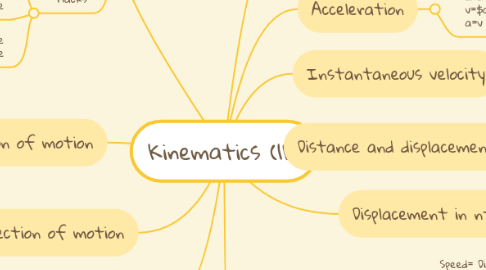Kinematics (1D)
Adrija Chatterjeeにより


1. Direction of motion
1.1. Direction of motion is given by velocity
2. Equation of motion
2.1. v=u+at S=ut+1/2at^2 v^2=u^2+2aS
2.2. The 's' here is displacement and not distance
3. Graphs
3.1. S-t graph
3.1.1. Slope=velocity
3.2. V-t graph
3.2.1. Slope= acceleration Area = distance + displacement
3.3. a-t graph
3.3.1. Slope= jerk Area= change in velocity
3.4. Hacks
3.4.1. Upward concave(bowl) a=+ve Downward concave (up side down bowl) a=-ve
3.4.2. Velocity acceleration same sign; speed increase Velocity acceleration different sign ; speed negative
3.4.3. Angle formed by tangent on x axis < 90° = velocity is +ve Angle formed by tangent on x axis > 90° = velocity is -ve
4. Relative velocity
4.1. ⊙Vab=Va-Vb (velocity of a with resp to b) ⊙Time + relative distance does not depend on frame of reference. ⊙under gravity relative acc = 0
5. Distance and displacement
5.1. Distance: scalar (S=$vdt) Displacement: vector Distance >= Displacement
6. Speed and velocity
6.1. Speed= Distance/ Time Scalar quantity
6.2. Velocity = Displacement/Time Vector quantity
6.3. Average speed = total distance/ total time
6.4. Average velocity = total displacement/ total time
7. Instantaneous velocity
7.1. (When time is very small) V(inst) =dS/dt
8. Displacement in nth second
8.1. S (nth)= S(n)-S(n-1)
9. Acceleration
9.1. a=dV/dt v=$adt a=v dv/dt
10. Motion under gravity
10.1. a=g=9.8/10m/s^2 a is constant
10.1.1. When point body is/thrown above reference point: Speed, displacement will be positive Acceleration negative
10.1.2. When point body is/thrown below reference point: Speed, displacement will be negative Acceleration negative
10.1.3. Tower sums will have initial and final position = height of tower
